
THE HOLY BLOOD AND THE SAINT-CLAIRS
About the unclear genealogy of
the Saint-Clairs, St. Claires, St. Clares and Sinclairs
by Vincent Mollet

THE HOLY BLOOD AND THE SAINT-CLAIRS
About the unclear genealogy of
the Saint-Clairs, St. Claires, St. Clares and Sinclairs
by Vincent Mollet
THE ORIGIN OF THE FAMILY
In 911 AD, the village of Saint-Clair-sur-Epte, in France, saw the signing of a Treaty between the French and the
Vikings which created the Duchy of Normandy. The newly-created Norman Dukes then entrusted this wild region to
a younger branch of their family: Walderne
(1006-1047), Duke Richard II's nephew, is the first recorded Lord of Saint-Clair.
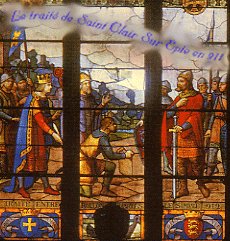
William (born 1028), Walderne's son, sought
fortune in Saxon England, then in Scotland, where he was made Baron of Rosslyn by King Malcolm. The Saint-Clair,
later Sinclair, Clan was founded.
The Saint-Clairs were, from their early days, connected with the founders of the Order of the Templar Knights,
either through Henry "the Holy",
the son of William, who took part in the First Crusade and the taking of Jerusalem in 1099 AD, or through Henry's
own son, Henry II, who greeted Hugues
de Payens, one of the first Knights Templars, and his kinsman by alliance, when the latter visited Scotland in
1129 (1). It also appears
that the Saint-Clairs, both in Scotland as well as on the Continent, contributed several knights to the Order (2).
However, the Saint-Clairs were not associated with the Templars just for the defense of the Holy Land. Through
them, they also became linked with a mysterious family called the Lineage of the Grail, whom the Templars were
sworn to protect. That, however, would not involve the Scottish branch of the family for a while.
THE FRENCH BRANCH
The first Saint-Clairs of Scotland still controlled the family estate in Normandy. When Richilde, daughter of Henry the Holy and sister of Henry II, married the French nobleman Robert de Chaumont (1134-1174), the estate of Saint-Clair-sur-Epte
became her dowry.
Robert, Earl of Saint-Clair (1160-1232),
the younger son of Richilde and Robert, named after his father, inherited the land and the title. He became the
ancestor of the French branch of the family.
Being connected by blood to the Lineage of the Grail (possibly through Robert's wife, Isabel Levis, or through
earlier alliances), the French Saint-Clairs soon acquired responsibilities in the Priory
of Sion, the occult branch of the Templars in charge of the Lineage.
Marie de Saint-Clair (1192-1266), daughter
of Robert de Saint-Clair and Isabel Levis, became Grand Mistress of the Priory from 1220 to her death (3). She had an affair with Emperor
Frederick II and her grandson and his consort, the heirs to the Grail, became the target of a world-wide manhunt
(4).
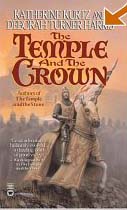 Arnault de Saint-Clair, Marie's grandnephew, a younger
son of a branch of the family resettled in Brittany, was a Knight Templar. Towards the end of the 13th Century
and the beginning of the 14th Century, like his Scottish cousins, he fought side by side with William Wallace and
Robert Bruce for Scottish independence (5).
Arnault de Saint-Clair, Marie's grandnephew, a younger
son of a branch of the family resettled in Brittany, was a Knight Templar. Towards the end of the 13th Century
and the beginning of the 14th Century, like his Scottish cousins, he fought side by side with William Wallace and
Robert Bruce for Scottish independence (5).
Jauffre de Saint-Clair, his French cousin,
was involved in rescuing the Treasure of the Templars after the Order was destroyed by King Philip IV of France
in 1307 (6).
Jean de Saint-Clair (born 1329) was another
of Marie's descendants (through from brothers ) who, like her, became a Grand Master of the Priory of Sion, from
1351 to his death in 1366 (7).
The French branch of the Saint-Clairs then did not call attention to themselves until the 18th Century, when a
Breton Knight named Saint-Clair was a
swashbuckler in the employ of King Louis XV (8). He may well have been the same Saint-Clair who fought in the French Canadian army during
the Seven Years' War. After their defeat, he stayed in America, thanks to the help of his distant Scottish Sinclair
relatives, who had just settled in Nova Scotia. That Saint-Clair eventually married a woman of the Sinclair branch.
Their son later founded a town in upstate New York which got his name and became the home of his descendants. (9)
Author Emil Sinclair (10) claimed that he was descended from a branch of
the Saint-Clair family converted to Protestantism, who had emigrated into Germany after the revocation of the Edict
of Nantes in 1685.
The French Saint-Clair family still exists today: Guichard de Saint-Clair (11)
recently claimed to be the direct descendant of a Saint-Clair Templar (notwithstanding their vow of chastity).
 The name
Saint-Clair has also been adopted by another branch of the Lineage of the Grail, the Plantards. These distant relatives tightened their links with the Saint-Clairs by the marriage, in 1548,
of Jean des Plantard with Marie de Saint-Clair. The Plantards, now Plantards de Saint-Clair, still play an important
role in the Priory of Sion (12)
-- their role is not quite as prestigious in an alternate reality where the Monarchy still rules in France and
their counterparts hold the Duchy of Lorraine (13).
The name
Saint-Clair has also been adopted by another branch of the Lineage of the Grail, the Plantards. These distant relatives tightened their links with the Saint-Clairs by the marriage, in 1548,
of Jean des Plantard with Marie de Saint-Clair. The Plantards, now Plantards de Saint-Clair, still play an important
role in the Priory of Sion (12)
-- their role is not quite as prestigious in an alternate reality where the Monarchy still rules in France and
their counterparts hold the Duchy of Lorraine (13).
From the 1980s to the 2000s, Lucrezia de Saint-Clair
used the power of the Priory to fight against the Templars for the control of the Grail. Her schemes were ultimately
defeated in 2004 by her son, David, born
in 1985 from her union with Knight Templar Robert von Metz (14).
Her cousin, French detective Sophie Neveu
(born ca. 1971), and whose mother was a descendant of both the Saint-Clairs and the Plantards, could well be the
most active Saint-Clair descendent today (15).
THE AMERICAN BRANCHES
As we have established, a French Saint-Clair,
a veteran of the Seven Years' War, was the ancestor of the American branch of the family. He had a good reason
not to return to France: since an encounter in the Canadian woods with a creature called Wendigo, he had become afflicted by the dreaded Wolf Curse, which he passed on to his descendants.
At the end of the 18th Century, his son, Stephen Morgan,
became the founder of a small town in upstate New York, which got his name, spelled "St. Claire," from
the family. He was also the progenitor of a line of werewolves still active today, scattered across the United
States (16).
Some of their descendents went West, becoming the Sinclairs settled in what is now the American government reserve of Ripple Creek, Colorado (17).
 Other Saint-Clairs
emigrated to French Louisiana, founding a new branch of the family, sometimes modifying the spelling of the their
name. After the Louisiana Purchase, some family members sought fortune in the North: the Sinclairs of New England
were a respected family, except for Rose Sinclair
who fled to Charleston and became an actress during the Civil War (18). That line became tragically extinct in 1892. The same fateful year also saw the disappearance
of Rose's brother, Rufus Sinclair (19).
Other Saint-Clairs
emigrated to French Louisiana, founding a new branch of the family, sometimes modifying the spelling of the their
name. After the Louisiana Purchase, some family members sought fortune in the North: the Sinclairs of New England
were a respected family, except for Rose Sinclair
who fled to Charleston and became an actress during the Civil War (18). That line became tragically extinct in 1892. The same fateful year also saw the disappearance
of Rose's brother, Rufus Sinclair (19).
As for the Saint-Clairs who stayed in Louisiana, by the mid-19th Century, their name was now spelled "St. Clare"; the fall of this great Southern family
was depicted by Harriet Beecher Stowe (20).
The posthumous son of Augustine St. Clare, Alexander St. Clare, was born ca. 1851 and was raised by the New England Sinclairs from Vermont, and thus adopted
their name's spelling. An army officer and military attaché, he traveled widely with his family. His wife,
Frieda Jane Bowie (born 1864), gave him one daughter and five sons. The daughter, Helga
Katrina Sinclair, born 1884, became an adventurer whose career ended violently
during an undersea expedition in 1914 (21).
The military tradition Alexander had established was carried on by First Lieutenant Luke
Sinclair, hero of the US Air Force in Europe during the Second World War (22), and by his daughter Lt. Col. Sinclair, who worked on a secret army research
program (23).
A younger daughter, Alison Sinclair, fights
crime in Miami, as a police captain (24). Her brother, John Sinclair,
has become a notorious mercenaryunder the code-name of Chant (25).
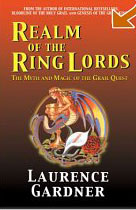 Another descendent
of Alexander Sinclair returned to Louisiana from which his family originated. That branch of the family produced
the famous Dr. Mark Sinclair who undertook
risky experiments with saurian serum (26). Mr. Dennis Power theorized that the effects of Dr. Sinclair's serum upon himself could be
due to the fact that he had a serpent-people ancestor. This could well be true: after all, the Lineage of the Grail
was also known as the Dragon Bloodline, and some authors have written about its reptilian origin (27). It is certainly not by luck that palaeontologists
nicknamed "Sinclairs" the recent evidence of humanoid reptilian life during the Secondary Era (28).
Another descendent
of Alexander Sinclair returned to Louisiana from which his family originated. That branch of the family produced
the famous Dr. Mark Sinclair who undertook
risky experiments with saurian serum (26). Mr. Dennis Power theorized that the effects of Dr. Sinclair's serum upon himself could be
due to the fact that he had a serpent-people ancestor. This could well be true: after all, the Lineage of the Grail
was also known as the Dragon Bloodline, and some authors have written about its reptilian origin (27). It is certainly not by luck that palaeontologists
nicknamed "Sinclairs" the recent evidence of humanoid reptilian life during the Secondary Era (28).
Mark Sinclair must not be confused with another Dr. Sinclair, possibly a nephew of his, who, around 1975, set up an infamous wax museum in a little Louisiana
town with his wife and two sons (29).
In the early 1950s, while her brother was experimenting, Debra Sinclair, alias Roulette,
was trying to rebuild the family's fortune in the New Orleans casinos. She became, by Neddy Sloane, the grandmother
of Veronica Sloane Sinclair, who later
took her grandmother's business and name over (30).
The family has conveniently forgotten John Sinclair,
another of Alexander's sons, who was framed for the murder of his wife's lover (31).
In California, one of the descendants of the Sinclairs married an Hispanic woman, and fathered Mariano and Orlando
"Hitmaker" Sinclair who grew up in the LA ghettos (32).
And in New York, a Lydia Sinclair obtained
the proof that the Grail was still influencing her family's life, even if in the most unexpected ways (33).
Finally, like a number of great Louisiana families, the St. Clares left their often-mispelled name (and their genes!)
to a number of their former slaves, hence the African-American Colonel Charles
"Chappy" Sinclair of the US Air Force (34). His known siblings are his brother, Earl, in Mississipi, and his sister, Rosa
Lynn, in Chicago (35). One of Earl's sons, David,
is active as a Federal Agent in Los Angeles (36). Let's not forget Nekra Sinclair,
one of Chappy's nieces, born an albino (37).
THE ENGLISH BRANCH
Like most great Norman families, the Saint-Clairs had estates on both sides of the Channel. An English branch soon
separated from the primary line, also becoming "St. Clare" then "Sinclair."
Lord Brett Sinclair, a modern-day descendent
and amateur historian, has often told the various adventures of this noble family (38).
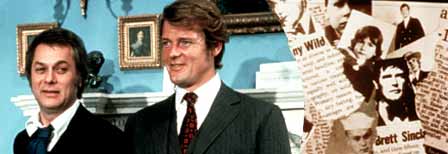
We don't know when, nor for what reason, some Sinclairs emigrated to Australia, becoming the starting point of
a branch which produced the Melbourne detective Mark Sinclair (39).
Another side of the family pompously retook the old spelling of the name, yet fell into poverty; in the 1880s,
Neville St. Clair (born 1852) was driven
to begging (40).
Among the Sinclair who stayed in England, at the end of the 19th Century, was Beatrice
Sinclair, an author and main protagonist of one of the strangest tales about
reincarnation (41).
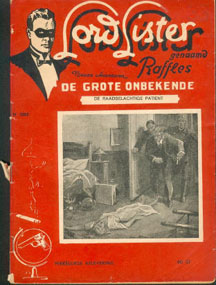 Her nephews,
around 1900, were five brothers and a sister. The latter, Cecily Sinclair, married the owner of a seaside hotel that she managed alone after her husband's death and
before her remarriage (42).
Among her brothers, John C. Sinclair,
a.k.a. Lord Lister, embarked on a crime
career à la Raffles, soon getting
various nicknames (the "Master Thief", the "Great Unknown") from the press (43); he even borrowed the name of Raffles after the
real A. J. Raffles had disappeared during the Boer War. An ironical and maybe not entirely random occurrence was
that, in 1906, his own uncle, the rich Marty Sinclair,
became the victim of the real A. J. Raffles (44)!
Her nephews,
around 1900, were five brothers and a sister. The latter, Cecily Sinclair, married the owner of a seaside hotel that she managed alone after her husband's death and
before her remarriage (42).
Among her brothers, John C. Sinclair,
a.k.a. Lord Lister, embarked on a crime
career à la Raffles, soon getting
various nicknames (the "Master Thief", the "Great Unknown") from the press (43); he even borrowed the name of Raffles after the
real A. J. Raffles had disappeared during the Boer War. An ironical and maybe not entirely random occurrence was
that, in 1906, his own uncle, the rich Marty Sinclair,
became the victim of the real A. J. Raffles (44)!
Dennis Power and Brad Mengel theorized (45) that Simon "The Saint" Templar (46),
born 1901, was the illegitimate son of A. J. Raffles. Actually, he was more likely the son of the second Raffles,
alias John Sinclair, as is evidenced by this name of "Templar" (reminding us of the ancient connection
between the Sinclairs and the Knights Templars), not to forget the astonishing physical resemblance between Simon
Templar and his nephew Brett Sinclair
(47).
Lord Lister eventually went straight, marrying Ellen Patrick-Baxter, the cousin of a Scotland Yard detective. However,
their son Neville Sinclair did not help
the family's reputation, being one of those members of the English aristocracy who became attracted to the Nazi
ideology. First a stage actor, he went to Hollywood where he secretly worked as German spy until his violent death
in 1942 (48).
The other children of Lord Lister and Ellen Patrick-Baxter had a far more righteous life. Few people remember that
their son Buck Sinclair was, in the 1930s,
an agent of the British Secret Service known as the Black Whip (49). He is better remembered as the peaceful 14th Earl of Marnock, whose own son became famous
as the aforementioned Lord Brett Sinclair,
one of the Persuaders (50).
Among of Lord Sinclair's cousins, Morgan Sinclair,
was the successful engineer who worked - at the peril of her life - on the English Channel Tunnel (51).
 Sadly, another
Sinclair, Christopher Sinclair, fell a
victim of vampirism (52),
a curse which had already at least once affected the family -- a vampiress called Morgana
Saint-Clair was destroyed in the 1970s (53). However, not knowing at which date, nor where she joined the Way of Blood, one can't determine
to which branch of the family she belonged. Nevertheless, ultimately faithful to his family's tradition, Christopher
Sinclair tried to prevent the desecration of the Grail.
Sadly, another
Sinclair, Christopher Sinclair, fell a
victim of vampirism (52),
a curse which had already at least once affected the family -- a vampiress called Morgana
Saint-Clair was destroyed in the 1970s (53). However, not knowing at which date, nor where she joined the Way of Blood, one can't determine
to which branch of the family she belonged. Nevertheless, ultimately faithful to his family's tradition, Christopher
Sinclair tried to prevent the desecration of the Grail.
It must also been noticed that Toby Sinclair,
one of Lord Lister's nephews, was a close friend of "Bulldog" Drummond, who, as we will see in the Scottish chapter, may have been one of his (very) distant relatives
(54). Strangely enough,
it's another Bulldog, his kinsman, whom the aviator Derek Sinclair, called upon in a case of necessity (55).
THE FITZROYS OF CLARE
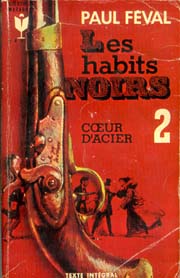 In the 17th Century,
during the English Revolution, a descendant of the family on the distaff side hid himself using the name of his
St. Clare cousins. His illegitimate daughter, born 1644, was the famous courtesan Amber
St. Clare. She had a son with Charles II Stuart, Charles, born 1667 (56)
whom the King acknowledged and who was the ancestor of the Fitzroys, Dukes of Clare.
In the 17th Century,
during the English Revolution, a descendant of the family on the distaff side hid himself using the name of his
St. Clare cousins. His illegitimate daughter, born 1644, was the famous courtesan Amber
St. Clare. She had a son with Charles II Stuart, Charles, born 1667 (56)
whom the King acknowledged and who was the ancestor of the Fitzroys, Dukes of Clare.
In the 19th century, members of the Clare
family were persecuted by the Black Coats, who tried to steal their inheritance; because of descending both from the Stuarts and from
the Lineage of the Grail, two members of the family had to be raised secretly and live under a name coming from
their ancestry.
Gabriel Sainclair was the father of Jacques Sainclair (b. ca 1875), who became Rouletabille's sidekick.
Gabriel's sister, Anne Sainclair, had
an affair with Théophraste Lupin,
and became the mother of Jean/Léo de Sainclair/Sainte-Claire/Saint-Clair (b. ca 1890), aka the Nyctalope (57).
One of the Nyctalope's sons became, like his uncle Arsène Lupin, and with the help of English and American
cousins on his mother's side, a wrongdoer for right causes: the con-man Marcel
Saint-Clair (58).
THE SCOTTISH BRANCH
It is time now to go back to the real cradle of the Sinclairs: Scotland, and to the descent of Henry II. The Scottish
lineage, like its continental kin, was related to the Knights Templars - mostly after the destruction of the order
- and the keeping of the Grail.
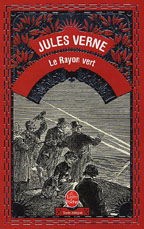 This may be
connected to the voyage that Henry Sinclair
(59) made in 1398 to
what would become North America (it is noticeable that this Henry Sinclair's son-in-law was called John Drummond, a name which could give a Sinclair ancestry
to one of the most prominent Wold Newton families).
This may be
connected to the voyage that Henry Sinclair
(59) made in 1398 to
what would become North America (it is noticeable that this Henry Sinclair's son-in-law was called John Drummond, a name which could give a Sinclair ancestry
to one of the most prominent Wold Newton families).
From here we jump to the 19th Century, when the painter Oliver Sinclair (born 1855) became famous for having pictured the Green Ray (60), a symbol often linked with the Grail.
His son was among the sailors who, during the First World War, discovered the lost island of Caspak (61).
The son of Seaman Sinclair, Jock Sinclair, was a piper and major in a Highlander regiment
during the Second World War (62).
Recently, among Jock Sinclair's grandchildren, no less than three cousins have worked with different organizations
stemming from the old Order of the Temple:
John Sinclair, the son of the Scottish
lawyer Horace F. Sinclair, is a psychologist,
Scotland Yard detective and ghost hunter, who several times had the chance to help the Templars secretly based
in Southern France (63).

The psychiatrist Adam Sinclair, aka "the
Adept", in addition of allegedly being a reincarnation of his aforementioned cousin Jauffre de Saint-Clair,
operates within the Hunting Lodge of Edinburgh (64).
Stuart Sinclair, at least, was a member
of the Order of the Knight of Light, and its banneret for Scotland (65). His daughter, Special Agent Morgan Sinclair, has recently inquired into the Louvre museum in Paris, and fought the schemes of a perverted
branch of the Templars (66).
The connection between the secret Templar offshoot known as the Knights of Light and several alien civilizations,
and their expeditions through time, could be at the origin of the Sinclairs' interest in those matters. It will
lead, in some of our possible futures, to Raymond Sinclair (d. 2126) researching the speed of time (67), to the birth of Jeffrey David Sinclair in a Martian colony, in 2218 (68), and to the work of Dr. Elliot Sinclair on the Journeyman Project for the Temporal Security Agency - the first time machine being
released in 2315 (69).
I've already mentioned the Sinclairs who had settled in Nova Scotia during the 18th Century. Their encounter with
their distant French cousin, the veteran of the Seven Years' war, did not bring them only a marriage and good memories:
this first St. Claire werewolf had infected them with the lycanthropic curse. They were forced to flee the area
soon after. One of them later worked for the Northern Legion Trading Company and was involved, during the 1814-1815
winter, in the Bailey Fort tragedy (70).
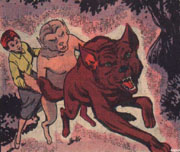 The main
branch of that side of the family returned to Scotland. There, some of them intermarried with an old werewolf community
known as the Tuatha de Danan, which had
been forced by its curse to flee to an extra-dimensional refuge. Their descendents later discovered a close cousin:
for another member of this branch, a woman who had turned to the wrong way, had delivered in 1970 a child of unknown
father, Rahne Sinclair, who became the
mutant known as Wolfsbane (71).
The main
branch of that side of the family returned to Scotland. There, some of them intermarried with an old werewolf community
known as the Tuatha de Danan, which had
been forced by its curse to flee to an extra-dimensional refuge. Their descendents later discovered a close cousin:
for another member of this branch, a woman who had turned to the wrong way, had delivered in 1970 a child of unknown
father, Rahne Sinclair, who became the
mutant known as Wolfsbane (71).
A WORD ABOUT THE LINEAGE OF THE GRAIL
Through the research which result you've just read, I never found any proof that the Saint-Clair/Sinclairs ever
mingled with the heroic lines coming from the Wold Newton encounter. Maybe they just didn't need it. According
to some versions of its legend, the Grail is actually, or is carved in, a lapis
ex coelis: a stone from the skies, a meteorite. I've already supposed, in
my Face-Stealer article (72),
that its effects could have been similar to those of the Wold Newton stone. Maybe it's what has permitted the Lineage
and Keepers of the Grail, and their more prominent representatives, the Saint-Clairs and Sinclairs, to shine for
now one millennium.
Vincent Mollet, 2006
(1000th anniversary of the birth of Walderne de Saint-Clair)
ACKNOWLEDGEMENTS
In addition to the source materials mentioned in the Notes below, this history of Sinclairs in fiction (73) would not have been possible
without various discussions on the Wold Newton Yahoo Group and the scholarship of its members. V.M.
NOTES
(1) About the origin and history of the Sinclair Clan, see www.clansinclairusa.org.
(2) (2) cf. Le Templier de Notre-Dame,
French graphic novel series, 1986-1997, by Willy VASSAUX (art) and Christian PISCAGLIA (story), taking place in
the 1240s, in which the protagonist is a Sinclair.
(3) cf. Holy Grail, Holy Blood,
1982, by Michael Baigent, Richard Leigh & Henry Lincoln..
(4) cf. Die Kinder des Gral
[The Children of the Grail], a German
book series, 1991-1997, by Peter Berling.
(5) cf. The Temple and the Stone,
1998, and The Temple and the Crown, 2001,
by Katherine Kurtz & Deborah Turner Harris.
(6) cf. "Obligation" in Tales of the Knight Templars, 1994, by Katherine Kurtz.
(7) cf. Holy Grail, Holy Blood,
q.v.
(8) cf. Le Chevalier de Saint-Clair,
French graphic novel series, 1992-1996, by Pierre Brochard. (link). (9)
cf. Wolf Moon, 1997, by John R. Holt.
(10)
cf. Demian,
1919, by Hermann Hesse.
(11) cf. Rapsodia per l'Unicorno
[Rhapsody for a Unicorn] by Oscar Cappelli.
(12) cf. Holy Grail, Holy Blood,
q.v.
(13) cf. Rex Mundi, comic
book series, 2005-present, by Eric Johnson (art) & Arvid Nelson (story).
(14) cf. Das Blut der Templer
[The Blood of the Templars], 2004, by
Wolfgang Hohlbein, and Das Blut der Templer II,
2005, by Wolfgang & Rebecca Hohlbein (link), adapted as a German television miniseries, 2004 (link).
(15)
cf. The Da Vinci Code, 2003, by Dan Brown.
(16) cf. Wolf Moon, q.v.
(17) cf. Beneath a Rising Moon,
2003, and Beneath a Darkening Moon, 2004,
by Keri Arthur.
(18)
cf. Love and War,
1984, by John Jakes, and its television miniseries adaptation, North and South, Book II, 1986 (link).
(19) cf. The Curse of the Living Corpse
(film), 1964 (link).
(20) cf. Uncle Tom's Cabin,
1852, by Harriet Beecher Stowe.
(21) ce. Atlantis: The Lost Empire
(animated film), 2001 (link). About Helga Sinclair, see here.
(22)
cf. Memphis Belle
(film), 1990 (link).
(23)
cf. Return of the Living Dead III (film), 1993 (link).
(24)
cf. Bad Boys
(film), 1995 (link).
(25) cf. the Chant book
series, 1986-92, by George Chesbro (link).
(26) cf. The Spider-Man
by Dennis Power (link). This article is based upon The Alligator People (film) 1959 (link), and the Spider-Man comics.
(27)
cf. Realm of the Ring Lords, 2000, by Laurence Garner and The Biggest Secret, 1999, by David Icke.
(28)
cf. Dinosaurs
(television series), 1991-1994 (link).
(29) cf. House of Wax
(film), 2005 (link).
(30) cf. JSA (comic book
series), DC Comics, 1999-present.
(31) cf. Voice of the Whistler
(film), 1945 (link).
(32) cf. Wonder Man (comic
book series), Marvel comics, 1993-present (link).
(33) cf The Fisher King
(film), 1991 (link).
(34)
cf. the Iron Eagle
film series, 1986-1995 (I, II, III and IV).
(35) cf. Down in the Delta (film),
1998 (link).
(36) cf. Numb3rs (television
series), 2005-present (link).
(37) cf. various Marvel comics, 1978-1990.
(38)
cf. The Persuaders
(television series), 1971-1972 (link).
(39) cf. the Mark Sinclair
short stories, ca 1865-1908, by Mary Fortune. Also see Jess Nevins' Victoriana site.
(40) cf. "The Man with the Twisted Lip" in The Adventures
of Sherlock Holmes, 1891, by Sir Arthur Conan Doyle.
(41) cf. Death, the Knight and the Lady,
1897, by Henry de Vere Stacpoole.
(42) cf. The Pennyfoot Hotel
book series, 1993-1999, by Kate Kingsbury.
(43)
cf. the Lord Lister
German pulp series (French version), 1908-1911, by Kurt Matull and Theo Blankensee. Also see Jess Nevins' site.
(44) cf. The Gentleman Thief (television
movie), 2001 (link).
(45) cf. The Incredible Raffles Clan
by Brad Mengel (link).
(46) cf. The Saint, book
series, 1928, by Leslie Charteris (link).
(47) cf. The Saint (television
series), 1962-1969 (link).
(48) cf. The Rocketeer
(film), 1991 (link).
(49) cf. The Ranger (British
comic book), 1931 (link).
(50) cf. The Persuaders,
q.v.
(51) cf. The Punisher,
Marvel Comics, 1992 (link).
(52) cf. Union Jack, Marvel
Comics, 1998 (link).
(53) cf. Vampire Tales,
Marvel comics, 1975 (link).
(54) cf. the Bulldog Drummond
book series, 1920, by Gerard Sapper & Fairlie.
(55) cf. Bulldog sees it through
(film), 1940 (link).
(56) cf. Forever Amber,
1944, by Kathleen Winsor.
(57) cf. Jean-Marc Lofficier's French Wold Newton Universe site and my own Face-Stealer
article.
(58) cf. The Rogues (television
series), 1964-1965 (link).
(59)
cf. The Lost Discovery, 1953, by Frederick J. Pohl. Also see Clan Sinclair's site.
(60) cf. Le Rayon vert
[The Green Ray], 1882, by Jules Verne.
(61) cf. Caspak, 1918,
by Edgar Rice Burroughs, and its film adaptation, The Land that Time Forgot, 1975 (link).
(62) cf. Tunes of Glory
(film), 1960 (link).
(63) cf. John Sinclair, Geisterjäger
[John Sinclair, Ghost Hunter], German
book series, 1978, by Jason Dark.
(64) cf. The Adept book
series, 1991- , by Katherine Kurtz & Deborah Turner Harris.
(65)
cf. Les Chevaliers de Lumière [The Knights of Light],
French book series, 1987-2003, by Jimmy Guieu.
(66) cf. Louvre: l'Ultime Malédiction [The Messenger],
video game, 2000.
(67) cf. the A.R.M. stories,
1975, by Larry Niven.
(68) cf. Babylon 5 (television
series), 1994-1999 (link).
(69) cf, The Journeyman Project,
video game series, 1992-1998.
(70) cf. Ginger Snaps: The Beginning (film),
2004 (link).
(71)
cf. The X-Men,
Marvel Comics. About the Tuatha de Danan in the Marvel Universe, see Marvel Appendix site.
(72) cf. The Face-Stealer
by Vincent Mollet, q.v.
(73)
The Scottish Sinclair Clan, originating from Normandy, actually exists since
the 11th Century. However, except for the first half of the chapter entitled The
Origin of the Family, everything you have read is fiction - as are the books
by Baigent, Leigh, Lincoln, Gardner, Icke, and the Sinclair chapter of Pohl's.

Article © 2006 Vincent Mollet. All rights reserved.
Art by B. Bonté from Le Vampire du West End
(Soleil, 2002).